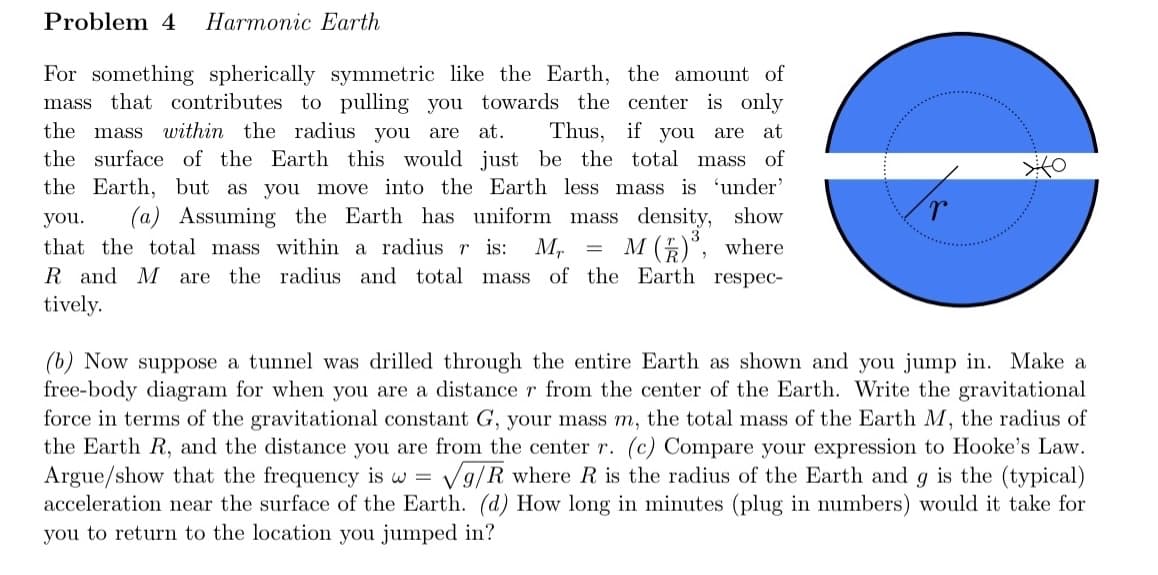Problem 4 Harmonic Earth For something spherically symmetric like the Earth, the amount of mass that contributes to pulling you towards the center is only the mass within the radius you are at. Thus, if you are at the surface of the Earth this would just be the total mass of the Earth, but as you move into the Earth less mass is 'under' you. (a) Assuming the Earth has uniform mass density, show that the total mass within a radius r is: M₁ = M()³, where R and M are the radius and total mass of the Earth respec- tively. (b) Now suppose a tunnel was drilled through the entire Earth as shown and you jump in. Make a free-body diagram for when you are a distance r from the center of the Earth. Write the gravitational force in terms of the gravitational constant G, your mass m, the total mass of the Earth M, the radius of the Earth R, and the distance you are from the center r. (c) Compare your expression to Hooke's Law. Argue/show that the frequency is w = √g/R where R is the radius of the Earth and g is the (typical) acceleration near the surface of the Earth. (d) How long in minutes (plug in numbers) would it take for you to return to the location you jumped in?
Problem 4 Harmonic Earth For something spherically symmetric like the Earth, the amount of mass that contributes to pulling you towards the center is only the mass within the radius you are at. Thus, if you are at the surface of the Earth this would just be the total mass of the Earth, but as you move into the Earth less mass is 'under' you. (a) Assuming the Earth has uniform mass density, show that the total mass within a radius r is: M₁ = M()³, where R and M are the radius and total mass of the Earth respec- tively. (b) Now suppose a tunnel was drilled through the entire Earth as shown and you jump in. Make a free-body diagram for when you are a distance r from the center of the Earth. Write the gravitational force in terms of the gravitational constant G, your mass m, the total mass of the Earth M, the radius of the Earth R, and the distance you are from the center r. (c) Compare your expression to Hooke's Law. Argue/show that the frequency is w = √g/R where R is the radius of the Earth and g is the (typical) acceleration near the surface of the Earth. (d) How long in minutes (plug in numbers) would it take for you to return to the location you jumped in?
Related questions
Question

Transcribed Image Text:Problem 4 Harmonic Earth
For something spherically symmetric like the Earth, the amount of
mass that contributes to pulling you towards the center is only
the mass within the radius you are at. Thus, if you are at
the surface of the Earth this would just be the total mass of
the Earth, but as you move into the Earth less mass is 'under'
you. (a) Assuming the Earth has uniform mass density, show
that the total mass within a radius r is: Mr = M()³, where
R and M are the radius and total mass of the Earth respec-
tively.
=
(b) Now suppose a tunnel was drilled through the entire Earth as shown and you jump in. Make a
free-body diagram for when you are a distance r from the center of the Earth. Write the gravitational
force in terms of the gravitational constant G, your mass m, the total mass of the Earth M, the radius of
the Earth R, and the distance you are from the center r. (c) Compare your expression to Hooke's Law.
Argue/show that the frequency is w = √g/R where R is the radius of the Earth and g is the (typical)
acceleration near the surface of the Earth. (d) How long in minutes (plug in numbers) would it take for
you to return to the location you jumped in?
Expert Solution
This question has been solved!
Explore an expertly crafted, step-by-step solution for a thorough understanding of key concepts.
Step by step
Solved in 2 steps with 1 images
